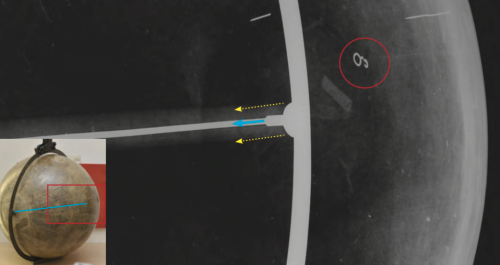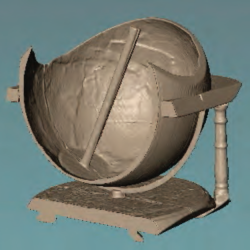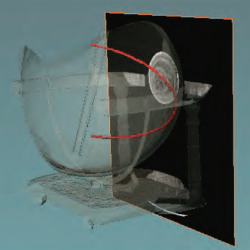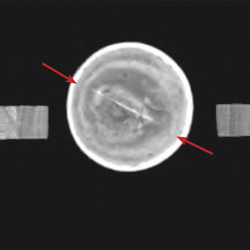Inner construction of the spheres
X-rays, computer tomography (CT) scans and 3D modelling of the resulting images made it possible to understand how the spheres were made.
Each hollow sphere is crossed by a metal shaft, probably made of brass, itself inserted in a wider wooden shaft. At each end inside the sphere a calotte, also made of wood, helps distribute the pressure from this axis for better balance when the globe is rotated.
- 3D modelling of the celestial globe: the sphere is crossed by a metal shaft (invisible here), itself encased in a wooden shaft. Each end is consolidated with a round calotte made of wood. © SIK|ISEA
- Transparent 3D modelling combined with a CT scan of a cross-section (black plate) almost tangential to the sphere. The red line shows where the two hemispheres are joined. © SIK|ISEA
- CT scan of a section nearly tangential to the sphere. The white background is full as the section is completely within the shell. The light line indicates the joint between the two hemispheres. © SIK|ISEA
In the terrestrial globe, X-ray and CT scan imaging pointed up a curious little piece of metal shaped like an “a” roughly 1 cm2. It is very close to and possibly even inside the southern wooden calotte. Its purpose is not very clear but it could be a system for fastening the wooden calotte to the sphere.

X-ray of the terrestrial globe. In the red circle, a little piece of metal shaped like an “a” sits very close to (possibly on or in) the southern calotte. The dashes are tiny nails, invisible from the surface of the sphere. It is difficult to determine whether these nails are originals or not. The blue line indicates the position of the metal shaft and the red rectangle the area of the film. The wooden shaft runs between the yellow arrows. © SIK|ISEA
Find out more
- CT scan of the structure : a series 578 computer tomodensitometry images were made of the terrestrial globe and 572 of the celestial globe to help better understand the spheres’ inner structure.
- X-rays of the structure : at the Swiss Institute for Art Research, Danièle Gros further analysed the globes’ structure using X-rays, revealing a number of additional details.
- Les globes de Mercator de l’Université de Lausanne. Observations matérielles. Constat d’état. Rapport de conservation-restauration : workshop and laboratory of the Swiss Institute for Art Research SIK|ISEA, Ref. No. 141110 0002: 01/02, October 2015, Margaux Genton, Zurich.


